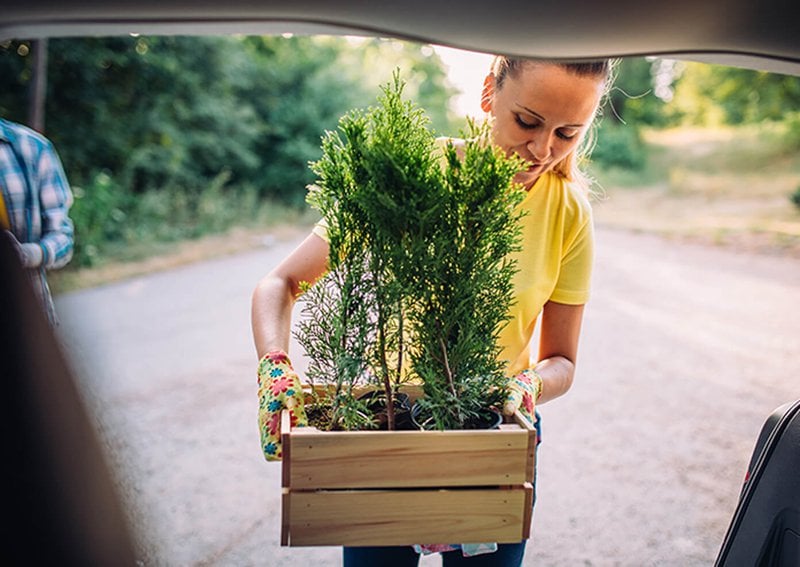
So it’s time to uproot, huh?
If you want your leafy friends to come with, it’s best to plan ahead. Much like packing your personal items for a small (or big) move, it takes a bit of shifting and ingenuity to get plants packed just right.
Take stock of your packing materials, size up your plants, and determine which ones can safely make the trip. Many professional moving companies won’t move live plants and doing it yourself ensures it gets done right.
These tips work best for smaller plants but can be used for medium-to-large plants, as well. Like all living things, plants require a balance of attention and careful handling, especially during moves.
Whether you’re bringing your new leaf babies home from the nursery or planning a cross-country trip, how you handle transportation is key to keeping plants healthy.
Here are some tips to keep you proud of your role as a plant parent.
Things to consider
If you’re moving, you already have plenty of other stuff to worry about, right? Plants can tag along, too, but it takes some prep work. Here’s a quick list of things to consider before you start shoving plants in boxes.
Size of plants and pots
Take inventory of your plants and which ones you can easily move. Consider your moving vehicle and space at your new destination when choosing which plants to relocate.
Digging and transplanting
Plan ahead for removing garden-based plants. Re-pot in plastic pots a few weeks prior to moving to lighten the weight load, while reducing the chance of pots breaking. When transplanting, don't dig right next to the plant — dig further out to include more roots. For smaller plants, gently break up the roots when repotting and use new potting soil.
Types of soil
Gardeners usually work with five types of soil: sandy, silty, clay, peaty and saline soil.
Soil helps plant growth by providing nutrients, water containment, oxygen and more. Talk to a local nursery expert to find out which type your plant needs. Easy tip: Add packing peanuts to the bottom of a pot lightens the weight of your planter and reduces the amount of soil required.
Distance to travel
How far will you travel? If you’ll be on the road for a few days, taking plants won’t be an issue. If you have more than two weeks of travel, you may want to reduce the number of plants moved as you’ll be taking them in and out at each overnight stop.
Don’t leave plants in the car
Extreme temperature changes will injure plants. Skip packing plants into the trunk; bring your plants into the car where air circulates better. Keep plants out of direct sunlight, if possible.
Just add water
Two to three days before hitting the road, water all plants. Moisten the soil without drenching the plant, but make sure the roots are damp.
Use protection
A light sheet (for larger plants) and newspaper (for smaller plants) protect foliage from winds and freezing temps. Use these during transport to save plants from frostbite.
Load plants last
Make your plants the last items to load into the car. If you’re moving in the middle of winter, try loading plants through the garage to minimize exposure to cold. Like your kids, plants should be one of the first things you take out of the car upon arrival at your new destination.
Before the trip
Doing some prep work prior to relocating your plants will make the transition smoother for you along the way.
Call ahead
Moving across state lines? Be sure to call ahead to your new home state (or country) to check rules for transporting plants. Certain states — like Florida and California — have strict rules about plant transportation. The USDA website is a great resource for specific plant transportation laws.
Prep your plants
Try not to move plants when in bloom, if possible. Prune away any dead branches and leaves a few weeks ahead of time. A couple days before moving, remove any bugs and weeds.
Collect proper materials
Old bed sheets protect leaves from the elements. Pruners help keep plants healthy along the trip. A spray bottle makes it easy to mist delicate plants without soaking the soil. Boxes, trash bags, and tree netting are other supplies to consider buying for the trip.
Take cuttings
If you can’t take your whole garden, take some clippings for transplant. Clippings take up less space. Wrap wet paper towels at the ends of clippings and secure with rubber bands. Gather clippings the same morning you plan to hit the road.
Consult a pro
If you’re unsure if your favorite orchid can make the trip, talk with a local nursery expert or a horticulturist. Have a list of concerns written out beforehand so you don’t forget to ask your most pressing questions.

With careful planning and preparation, your garden can move along with you. There's no need to make like a tree and never move if you just can’t leave your flowers behind.
Transporting your favorite plants takes patience and planning — and a bit of careful driving. By creating an atmosphere as close as possible to the plants' current environments, your plants are more likely to survive. Worst-case, if your plants don’t make the drive, you’ll have an excuse to visit your new local nursery to buy yourself a housewarming gift.
If you’re not sure whether a plant will survive the move, it’s probably best to leave it behind with a friend.
By the end of your road trip with plants, you may be quoting the wise Shel Silverstein: "What did the carrot say to the wheat? Lettuce rest, I'm feeling beet."
You might be beet, but at least you’ll be ready to take root.
Ready to start saving?
